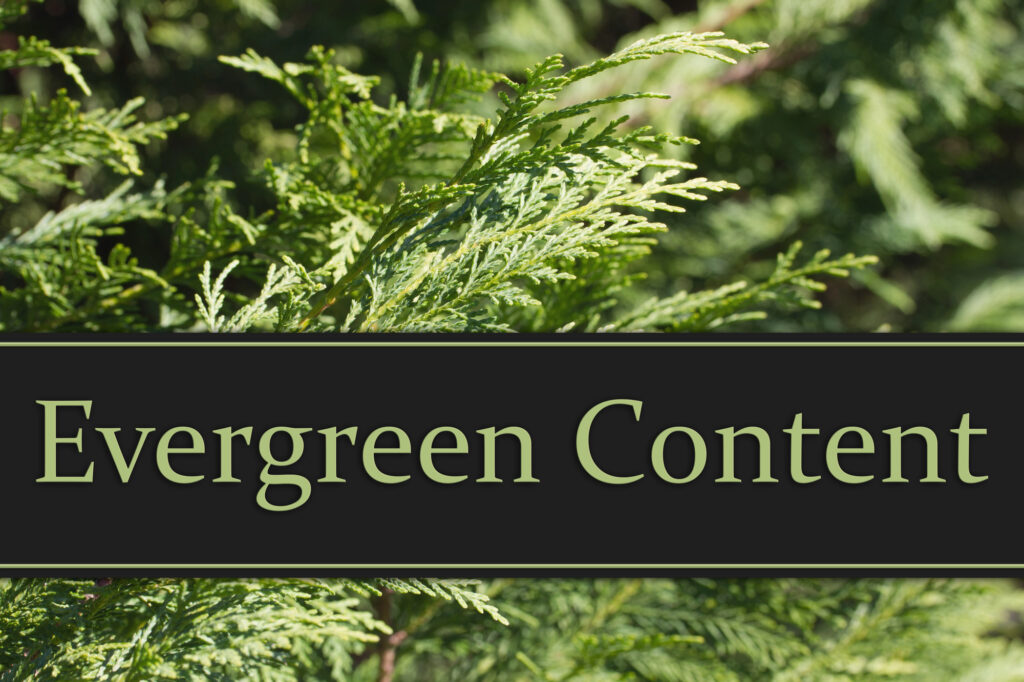Creating content that remains relevant over time is essential for most content creators. This kind of content, known as evergreen content, doesn’t just fade into the digital abyss. Instead, it continues to provide value and engage new audiences. But what makes evergreen content so enduring? And how can you create it? I’ve got the ins and outs to help you discover the secrets of crafting posts that stand the test of time.

What is evergreen content?
Evergreen content is the kind of content that remains relevant regardless of current trends or seasons. Think of it as a classic novel that remains popular through the years. Unlike trending topics that might only be relevant for a short period, evergreen content addresses timeless topics or questions that always have value.
Why create evergreen content?
Evergreen content offers several long-term benefits that are valuable additions to any content strategy.
Long-term traffic
One of the biggest advantages of evergreen content is its ability to generate traffic over time. A well-written post on a timeless topic will keep bringing in readers long after its initial publication.
SEO benefits
Search engines love content that remains relevant. Evergreen posts tend to rank well because they address consistent topics people are constantly searching for.
Cost-effective
Creating content that continues to provide value reduces the need for frequent updates or new content. It’s a one-time investment that can keep paying off.
Authority building
By providing in-depth and helpful information on a consistent topic, you establish yourself as an authority in that area, which can enhance your credibility and attract a loyal audience.
How to create evergreen content
Creating evergreen content involves several key strategies that ensure your posts remain relevant and valuable in the long run.
Choose timeless topics
When selecting a topic, consider subjects that are consistently relevant to your audience. For instance, a blog post about “How to Budget Effectively” will likely be valuable to readers for years to come. Compare this to a post about a specific event or trend, which might become outdated quickly.
Focus on quality and depth
Evergreen content should be comprehensive and provide real value. Aim for thoroughness in your research and writing. For example, if you’re writing a guide on “Essential Gardening Tips,” cover a broad range of tips, from soil preparation to pest control. The more detailed and useful your content, the more likely it is to remain relevant.
Update and refresh
While evergreen content is designed to last, periodic updates can keep it relevant. Review your posts regularly and make adjustments to ensure accuracy. For instance, if new gardening tools become popular, updating your post with this information can provide added value.
Use a timeless tone
The way you present your information can also impact its longevity. Avoid trendy language or references that might become outdated. Stick with a tone and style that will resonate with readers regardless of when they come across your content.
Optimize for search engines
Evergreen content should be optimized for search engines to ensure it reaches your target audience. This means using relevant keywords, creating compelling meta descriptions and including internal links to related content. However, don’t overstuff your content with keywords; focus on natural, reader-friendly language.

Provide practical tips and solutions
Practical advice and solutions can be more enduring than theoretical or opinion-based content. For example, a post on “Basic Car Maintenance Tips” offers actionable advice that readers can apply, making it useful over time.
Examples of evergreen content
To better grasp what makes content evergreen, consider these examples that consistently provide value and relevance.
How-to guides
These are instructional pieces that provide step-by-step guidance on various topics. Whether it’s “How to Start a Blog” or “How to Cook the Perfect Steak,” these guides remain useful as they address fundamental skills or knowledge.
FAQs
Frequently Asked Questions pages address common inquiries in your industry or niche. Since these questions don’t change much, the content remains valuable for a long time.
Product reviews
Reviews of timeless products or services can also be evergreen. For instance, a review of a classic cookbook or a reliable smartphone model can attract readers over the years.
Resource lists
Comprehensive lists of resources, tools or references on a particular subject can be valuable. Think of a post like “Top 10 Free Tools for Graphic Designers” or “Best Books for Aspiring Writers.”
Recipes
For food bloggers, most recipe content is evergreen content, except for seasonal recipes.
Promoting your evergreen content
Effective promotion is crucial to maximizing the reach and impact of your evergreen content so it continues to attract and engage readers.
Social media
Share your evergreen content on social media platforms to reach a broader audience. Even though the content is timeless, promoting it regularly can help attract new readers.

Email newsletters
Include evergreen content in your email newsletters. This can be a great way to provide continuous value to your subscribers and encourage them to revisit your site.
Internal linking
Link to your evergreen content within other posts on your site. This not only helps with SEO but also guides readers to additional valuable information.
Repurposing
Consider repurposing your evergreen content into different formats. For example, turn a blog post into an infographic, video or podcast episode. This can help reach different types of audiences and keep the content fresh.
Final thoughts
Creating evergreen content is like planting a tree. It requires effort up front, but with time, it can grow and continue to bear fruit for years. By focusing on timeless topics, providing high-quality information and optimizing for search engines, you can craft posts that stand the test of time and keep attracting readers. So, the next time you sit down to create content, always think long-term.
Jennifer Allen, co-founder of Brilliant Bloggers and Food Drink Life, is a retired professional chef and long-time writer. Her work has been featured in numerous top publications worldwide, including The Seattle Times, Morning AG Clips, Chronicle-Tribune, Los Angeles Daily News and Daily Press, among others. She manages nine personal websites and has authored two cookbooks, “Keto Soup Cookbook” and “Keto Diabetic Cookbook and Meal Plan.” These days, she’s busy in the kitchen, developing recipes for various publications and traveling. You can find all her best recipes at Cook What You Love.
